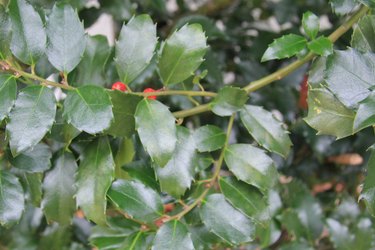
If you're growing holly primarily for decking the halls at Christmastime, the American holly (Ilex opaca) is often the tree of choice. American holly, a tree, grows best in U.S. Department of Agriculture plant hardiness zones 5 through 9. For a more shrubby holly that grows in the same USDA zones, opt for a hybrid, such as blue holly (Ilex x meserveae, USDA zones 4-7), which is also evergreen. Another option in this genus that also boasts beautiful red berries is the winterberry shrub (Ilex verticillata, USDA zones 3-9).
Check with your local nurseries to decide which species is best for your landscape. These trees and shrubs are a beautiful addition to your outdoor winter landscape, and the holly and winterberry stems and sprigs are perfect for making your Christmas decorations brighten up the holiday season.
Video of the Day
Video of the Day
To keep the holiday spirit alive, prepare your harvested branches before any DIY crafting or holiday decorating. Holly keeps its fresh look best with either air-drying, spraying or glycerin preservation.
Bountiful red berries
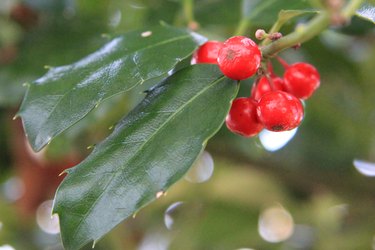
Hollies prefer full sun to partial shade and acidic soil with a low pH, which should be kept consistently moist but not waterlogged. If you live in USDA zones 8 through 9, plant the holly where it will get afternoon shade. If the plants fail to produce berries, plant more male holly bushes nearby—the berry-bearing females need male hollies to produce fruit.
A springtime pruning of each bush will produce more berries later in the season. To nourish hollies, spread 2 inches of compost under the shrubs every spring.
Harvest holly and winterberry branches
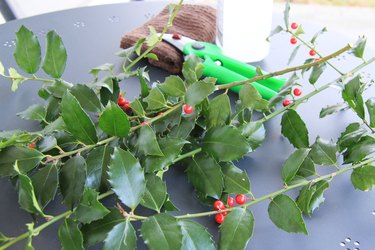
It's best to clip holly while temperatures are still above freezing. An overcast day with minimal wind makes an ideal harvesting day. Look for branches that are packed with ripe berries and glossy greenery. Winterberry is a deciduous shrub, so it will give you a different look with red berries on bare branches.
Avoid boughs in which either the berries or the leaves are discolored or damaged. Use properly sharpened shears that you've wiped with a cloth soaked in rubbing alcohol. Clean, sharp shears decrease the risk you'll spread disease or damage the hollies through poor pruning.
Methods for drying holly bushes
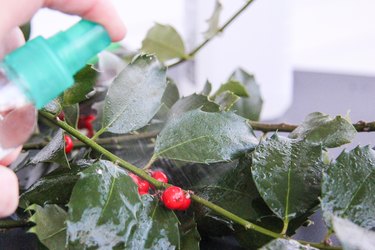
The trick to "drying" holly branches is to prevent them from looking dried out. You want a fresh look for your holly garlands, centerpieces and front-door wreaths.
For the most basic technique, use the air-drying method, which helps preserve the colors of holly's leaves and berries. The faster glycerin treatment will help the boughs remain colorful and pliable by quickly replacing plant sap with the glycerin preservative. If you're really in a rush, spritz on an anti-desiccant spray, which prevents premature moisture loss. This spray can also extend the life of a glycerin treatment.
Air drying holly and winterberry
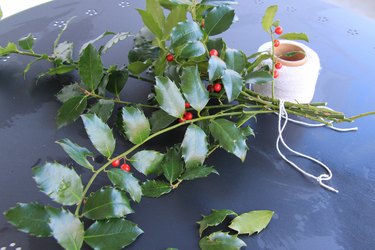
To air dry holly, start by removing the leaves from the lower parts of each branch you've harvested. Prepare a bundle by loosely gathering as many holly branches as you can comfortably grasp with one hand. Twist ties, elastic bands or string work well to secure the branches at their pruned end. To provide them with a place to hang, use nails or hangers placed high up in a dark, draft-free room.
The proper way to hang holly is stem side up, with the branches hanging straight down. Dry the holly for about three weeks before using it for decoration.
Guard with glycerin
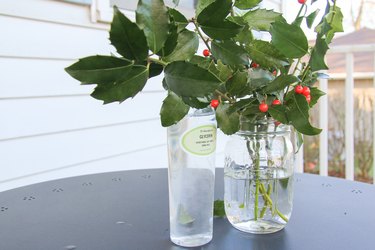
To do the glycerin treatment, stand the holly branches upright, in loose bundles, inside a large jar holding a few inches of glycerin solution, preferably after you've sliced into or crushed the lower 2 inches of each holly branch. To make the solution, mix 2 parts glycerin to 1 part boiling water, and mix it thoroughly.
Alternatively, soak whole holly branches in a long bin deep enough to submerge the boughs. After the branches have stood in the glycerin jars or laid in their bins for about three days, the last step is to air dry them upside down in a dark, draft-free room for a few days until they are completely dry.
Spray-on freshness for holly
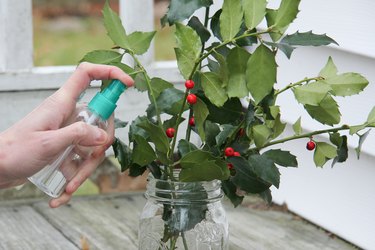
Anti-desiccant sprays can be used on holly branches either alone or as a follow-up to glycerin treatment. Available at floral supply stores, anti-desiccant sprays reinforce holly leaves' natural waxiness. In turn, this waxy coating decreases the amount of moisture loss so that holly leaves and stems don't become crisp and brown before their time. Spray the branches thoroughly after either soaking them in plain water or in a glycerin and water solution.